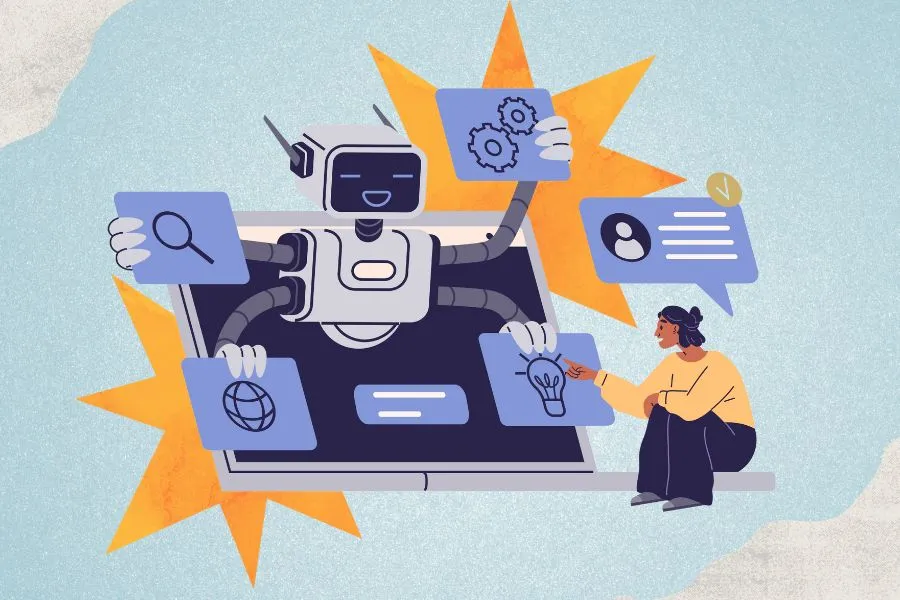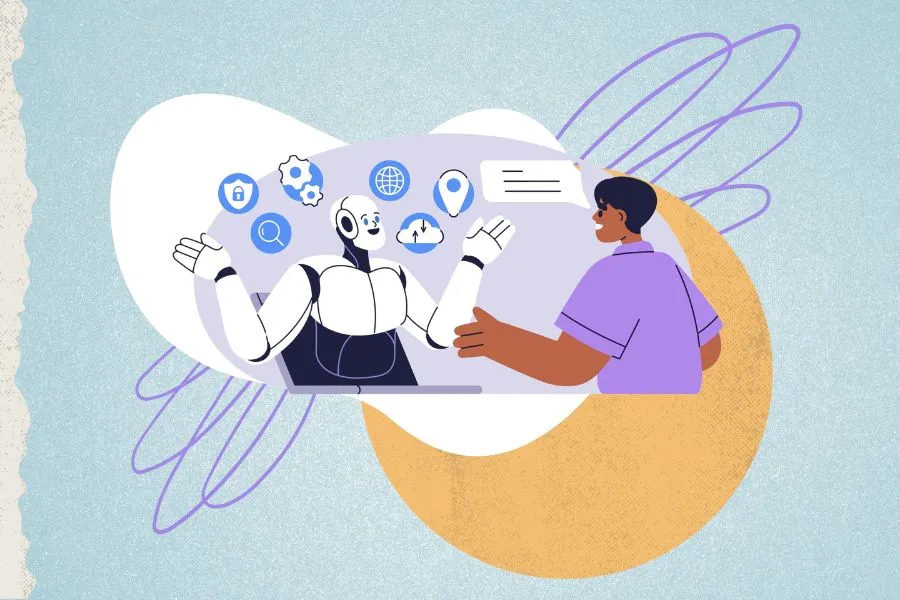In an era of uncertainty and change, it is becoming increasingly important to integrate technological advances, particularly artificial intelligence (AI), said Carlos Recordon, Associate Dean of High School Academics at PrepaTec.
During IFE Conference 2025, Recordon participated in a workshop together with:
- Isaac López, national leader of Spanish and Literature, Social Sciences, and Humanities at the Tec
- Zianya Arizpe, national leader of Foreign Languages and International Baccalaureate certification
- Laura Roa, national leader of Mathematics, Science, and Technology
CONECTA shares some of their tips to facilitate the process of integrating technological advances into the classroom.

PROMPTING: Giving better instructions
1. Know the basic structure of an effective prompt
2. Provide context, be specific, and clarify the tone you are looking for
3. Be specific but avoid being restrictive with your prompt
4. Reiterate and refine as many times as necessary
5. Don't be afraid to experiment with the bot
6. Ask for help and modify with the assistance ok AI itself
CREATING TEACHING AIDS
7. Get to know the platforms and experiment whit them
8. Pay close attention to details and information used
CUSTOMIZING LANGUAGE MODELS
10. Create a detailed virtual assistant
11. Challenge your students to program their owns bots
ETHICAL PRACTICES IN THE CLASSROOM
12. Anonymize the data and verify information
13. Think of how AI serves humans
14. Develop strategic competencies
15. Define clear guidelines to moderate its use
1.- PROMPTING: How to give better instructions
Recordon recommended that you begin your prompt with a clear and concise instruction or question that defines your objective for the AI.
A prompt is an instruction, question, or input text that is provided to an artificial intelligence or automated system to generate a specific result.
The workshop leader suggested including an example to illustrate your request so that the AI can have a reference of what you are looking for in your result.
Indicate the desired format for your answer: if you want bullets, tables, running text, text length, etc.
2.- Provide context, be specific, and clarify the tone you are looking for
Provide relevant information for the model to understand the topic or scenario. Include the person or perspective the AI is writing from and the intended audience.
“Define your requirements as precisely as possible,” said the Associate Dean.
Just as Recordon encouraged being specific about the desired format, he also recommends defining the desired tone for the audience (formal, informal, humorous, serious, youthful, etc.).
3.- Be specific, but avoid being restrictive with your prompt
According to the speaker, while it is important to be as specific as possible to ensure that the AI’s response is what you are looking for, it is also important to make sure that the language model is not limiting itself too much.
In addition to the fact that too many constraints can create short answers that merely meet the given objectives, Recordon explained that the prompting process can also be used as a creative exercise.
“Provide enough information to guide the AI, but leave room for creativity and innovation,” the Associate Dean said, encouraging the use of prompting as a space for brainstorming.

4.- Repeat and refine as many times as necessary
Although one of the most common benefits of using any type of AI is to shorten the time needed for basic tasks, the workshop leader said that getting more than one answer is not only desirable, but essential to its use.
The Associate Dean emphasized the importance of not sticking with the first answer that AI suggests and, instead, making adjustments until you get the one that best suits or even exceeds what you need.
“If the results are not optimal, gradually adjust the prompt to get better responses,” said Recordon.
5.- Don’t be afraid to experiment with the bot
The workshop participants not only agreed that it is valid to tune the prompt to your specific needs, but they also encouraged experimentation with modifications to the original prompt.
Changing the audience, the format, or even the information or product you are requesting can lead to the AI suggesting ideas or resources that it did not previously consider.
“Try different approaches and formulations for the prompt and see how they affect the results,” the Associate Dean said.
6.- Ask for help and modify with the assistance of AI itself
As part of the process of modifying the prompt, asking for a second opinion can help you create more precise instructions or give you input on what is not working.
Although a teacher can serve this process, Recordon also suggested using AI itself to refine the structure or constraints of the original prompt.
“Ask AI to help you refine your prompt for accurate and relevant results,” the Associate Dean suggested.

Creating teaching aids
7.- Get to know the platforms and experiment with them
On the other hand, both López and Arizpe shared with other teachers how AI can help save time when creating teaching aids such as presentations, language models such as bots, etc.
For this, the workshop participants suggested being familiar with the variety of AI tools that exist today, particularly the elements that distinguish one from another, their limitations, and how to use them.
While there is a wide selection of tools and applications that use AI, López suggested using platforms such as Gamma for creating presentations due to its user-friendly interface and variety of functions.
8.- Pay close attention to details and the information used
While López acknowledges the ability of today’s AI tools to create quality material in a relatively short time, he also says that it is imperative for teachers to review every detail.
A common mistake the speaker mentioned is when AI has to create or collect information from scratch, as when it’s asked to “fill in the blanks” and may make factual or wording errors and/or provide outdated data.
To this end, the national leader recommended carefully reviewing the results provided by the AI and, in the case of classroom material, opting for one’s own material and letting the tool merely suggest how to use it.
9.- Try to use multiple tools
Acknowledging that technological tools are not error-free, López also reiterated that even if you use advanced AI models, each platform has its specialties and limitations.
Thus, the workshop leader suggested using and combining different tools in the same class to create different resources with platforms “specialized” in what you are looking for (images, text, audio, etc.).
One example of this is starting from a language model such as ChatGPT to suggest an outline or develop a text, passing the revised results to a visual platform such as Gamma, and then evaluating the results with Classpoint.
CUSTOMIZING LANGUAGE MODELS
10.- Create a detailed virtual assistant
López explained that teachers can create and add their own language models and program them in a way that uses an internal database instead of connecting to a pre-existing one.
With platforms such as Poe, teachers can modify the assistant in a way that allows it to find and organize information and even create material without using external data or resources.
According to the workshop participants, this is particularly useful as it is similar to having an assistant who already “knows” the class material and can present it in the way that works best without always needing to start from scratch.
11.- Challenge your students to program their own bots
Similarly, the speakers said that chatbots can serve as a classroom activity or even a support during the semester if students themselves are challenged to modify them with class content.
With Poe, in addition to creating wizards to help you navigate the material, you can also task it with role-playing to challenge learners and help them study.
Again, López stressed the importance of teaching students to review the information regardless of the database used and to get them used to not sticking with the first answer.
Ethical practices in the classroom
12.- Anonymize data and validate information
Not providing any personal or student data while implementing a fact-checking process is imperative for the ethical use of AI tools in the classroom, Arizpe explained.
The anonymization process consists of removing or modifying personal data so that it cannot be linked to a specific individual, thus reducing the risks of misuse or leaks.
Considering that misinformation can spread rapidly, the workshop participants believe it is necessary to teach and reinforce rigorous verification methods, such as checking sources and using tools to detect inconsistencies.

13.- Think of how AI serves humans
According to Arizpe, the purpose of AI is in part to improve efficiency and accuracy in tasks that usually require a relatively high amount of human time and attention.
However, the panelists stressed that its implementation should always be aimed at complementing and enhancing human capabilities rather than replacing them, something that both teachers and students should be aware of.
Thus, the leader stressed that, above all, AI should be seen as an ally of human beings, always under the supervision and judgment of those who use it.
14.- Encourage the use of creative AI as part of the curriculum
In addition to setting an example with classroom resources, Recordon added the variety of secondary uses that can arise from AI to help students see topics differently.
Along this line of thinking, Recordon points out activities that can challenge students to create poems, images, or other artistic products from specific prompts linked to the subject matter.
Similarly, the Associate Dean suggested activities in which work is done “backwards” from the product to try to find the closest prompt to the original.
15.- Define clear guidelines to moderate its use
Establishing clear guidelines for the use of technology, particularly artificial intelligence, is essential in order to mitigate risks and ensure a positive impact in the classroom, agreed the workshop participants.
The creation of guidelines within the classroom can ensure that – for the most part – the classroom is used responsibly and adds value to the course being taught.
Recordon stresses that this is not about avoiding the use of AI altogether, as this could be counterproductive. It is about providing guidance and boundaries that help both parties explore these technologies while developing key skills for the future.
IFE Conference 2025
The IFE Conference is one of the most important events in educational innovation in the Spanish-speaking world, organized by the Tec de Monterrey’s Institute for the Future of Education (IFE).
This is the eleventh edition of this event, formerly known as the International Conference on Educational Innovation (CIIE).
The Monterrey campus hosted this international educational conference from January 28 to 30, with 4,759 attendees from 40 countries. Of these, 3,965 were in-person participants and 794 were virtual participants.
READ MORE:





